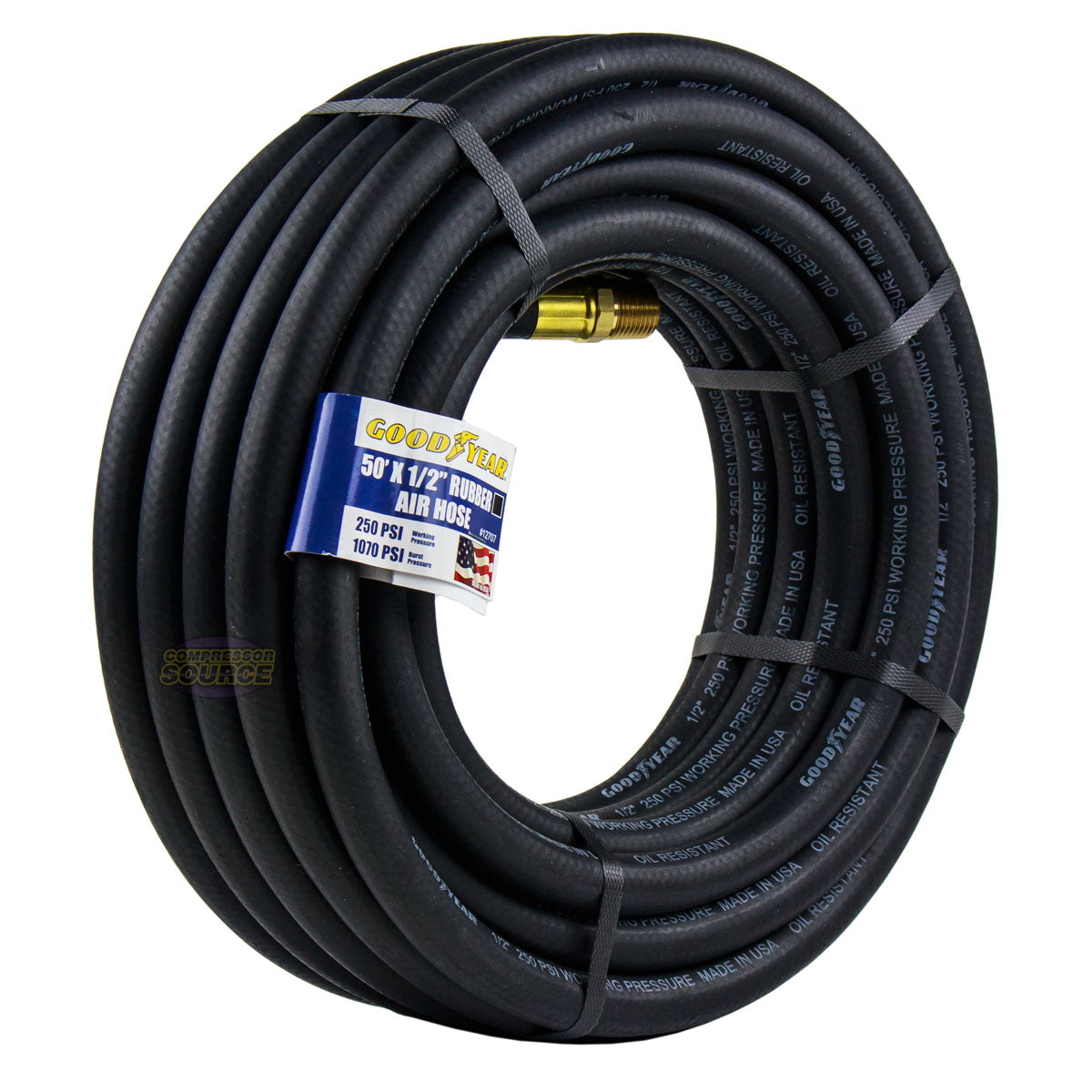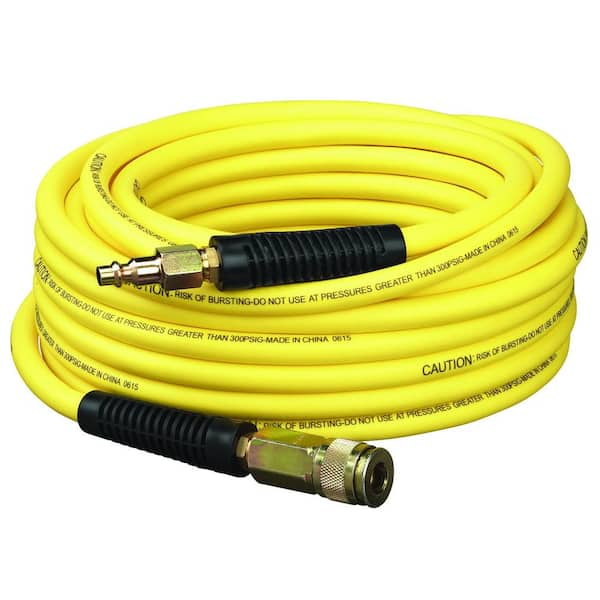If you’re tired of struggling with short, stiff air compressor hoses that limit your reach and slow down your work, it’s time to upgrade. A 50 ft air compressor hose gives you the freedom to move around your workspace without constantly unplugging and reconnecting.
Imagine finishing your tasks faster, with less hassle and more efficiency. You’ll discover why a 50 ft air compressor hose could be the game-changer you need, how to choose the right one, and tips to keep it working like new.
Keep reading to make your air compressor work smarter, not harder.
Choosing The Right Hose Material
Selecting the right material for a 50 ft air compressor hose is important. It affects performance, durability, and ease of use. The right hose material handles pressure well and lasts long.
This section explains key materials and how they compare. Understanding these options helps pick the best hose for your needs.
Rubber Vs Pvc
Rubber hoses are flexible and strong. They resist wear and handle high pressure well. Rubber also stays soft in cold weather, making it easier to use.
PVC hoses are lighter and less expensive. They work well for low-pressure tasks. PVC hoses are less flexible and can crack in cold conditions.
Hybrid Options
Hybrid hoses mix rubber and PVC materials. They aim to balance flexibility, weight, and durability. These hoses often last longer than pure PVC but stay lighter than full rubber.
Hybrids work well for users needing a good mix of toughness and easy handling.
Durability Factors
Look for hoses with strong outer layers to resist cuts and abrasions. Hose thickness affects how long it lasts under tough use.
Check for resistance to kinks and twisting. A durable hose keeps air flowing smoothly without damage.

Credit: compressor-source.com
Hose Diameter And Length Impact
The diameter and length of a 50 ft air compressor hose greatly affect its performance. These factors influence airflow, pressure, and overall efficiency. Choosing the right hose size and length helps you get the best results from your air compressor. Small changes can make a big difference in how well your tools work. Understanding these impacts guides you to the right hose for your needs.
Matching Hose Size To Compressor
Choose a hose diameter that fits your compressor’s output. A hose too small restricts airflow and lowers pressure. A hose too large can be bulky and hard to handle. Check your compressor’s manual for recommended hose sizes. Proper matching ensures smooth air delivery and efficient tool use.
Effects On Airflow
A larger diameter hose allows more air to pass through easily. This keeps pressure steady and tools running well. A narrow hose causes air resistance and pressure drops. Airflow loss can reduce tool power and slow work. Keep hose diameter consistent with compressor capacity for best airflow.
Optimal Length Considerations
Long hoses give freedom to move around your workspace. But longer hoses can reduce air pressure at the tool end. Pressure loss increases with hose length. Use the shortest hose length that fits your job. Balance length and flexibility for steady air pressure and ease of use.
Fittings And Connectors
Fittings and connectors play a key role in using a 50 ft air compressor hose. They link the hose to tools and the compressor. Good fittings make sure air flows smoothly. They stop leaks and keep the system safe. Choosing the right connectors helps the hose last longer. It also makes work easier and faster.
Common Connector Types
There are several common types of connectors for air hoses. Quick-connect fittings let you attach and detach tools fast. Threaded connectors screw tightly to prevent air leaks. Push-to-connect fittings offer simple and secure connections. Each type fits different tools and compressors. Knowing these helps you pick the best one for your needs.
Ensuring Leak-free Connections
Leaks waste air and reduce power. Tight fittings stop leaks at the connection points. Use Teflon tape on threaded connectors to seal joints. Check connectors regularly for wear or damage. Replace any parts that look worn or cracked. Proper maintenance keeps the hose working well and saves energy.
Quick-connect Advantages
Quick-connect fittings save time during work. They snap on and off without tools. This helps switch between tools quickly on the job. These connectors also reduce the risk of air leaks. They fit snugly and lock in place. Quick-connects make using a 50 ft air compressor hose much easier.

Credit: www.amazon.com
Maintenance Tips For Longevity
Taking care of your 50 ft air compressor hose helps it last longer. Proper maintenance keeps the hose safe and working well. Small efforts can prevent big problems later. Follow these easy tips to keep your hose in top shape.
Regular Cleaning
Clean the hose after each use. Dirt and dust can damage the material. Use a soft cloth and mild soap. Avoid harsh chemicals that can weaken the hose. Dry it completely before storing. Clean hoses stay flexible and strong.
Storage Best Practices
Store the hose in a cool, dry place. Avoid direct sunlight and heat. Roll the hose loosely to prevent kinks and bends. Do not hang it by the fittings. Proper storage stops cracks and leaks. A well-stored hose lasts much longer.
Inspecting For Wear And Damage
Check the hose regularly for cracks or holes. Look closely at the fittings for rust or wear. Replace the hose if you find any damage. Using a damaged hose can cause accidents. Early inspection saves money and keeps work safe.
Safety Precautions
Using a 50 ft air compressor hose safely is important. Safety helps prevent accidents and keeps tools working well. Follow key steps to protect yourself and your equipment.
Pressure Ratings
Check the hose’s pressure rating before use. The hose must handle the air compressor’s pressure. Exceeding this limit can cause the hose to burst. Always use a hose with a higher pressure rating than your compressor.
Avoiding Kinks And Twists
Keep the hose straight and free from sharp bends. Kinks block air flow and weaken the hose. Twists can cause damage and leaks. Store the hose coiled properly without tight loops.
Handling High Temperatures
Air compressor hoses can get hot during use. Avoid touching the hose immediately after use. High temperatures can cause burns or damage to the hose material. Let the hose cool down before handling or storing it.
Top Brands And Models
Choosing the right 50 ft air compressor hose means knowing the top brands and models. Quality brands offer hoses that last long and work well. They provide good air flow and resist kinks or cracks. This section covers popular choices, budget-friendly options, and premium performance hoses. Each category helps match your needs and budget.
Popular Choices
Many users trust brands like Goodyear, Flexzilla, and Craftsman. These brands have a strong reputation for durability and performance. Their hoses work well for home and professional use. Goodyear hoses are known for their tough outer layer. Flexzilla offers flexibility even in cold weather. Craftsman hoses balance price and quality nicely.
Budget-friendly Options
For users on a tight budget, brands like California Air Tools and PowRyte offer good value. These hoses provide solid performance without a high price. They are lightweight and easy to handle. Budget hoses suit casual or occasional use. They may lack some features but still get the job done well.
Premium Performance Hoses
Premium hoses deliver top performance for heavy use and tough jobs. Brands like Goodyear Pro and Campbell Hausfeld lead this category. Their hoses resist abrasion and extreme temperatures. These hoses maintain good air flow under high pressure. They often come with longer warranties and better build quality.
Troubleshooting Common Issues
Troubleshooting common issues with a 50 ft air compressor hose helps keep your tool working well. Simple problems can stop your work. Knowing how to fix them saves time and money. This guide covers the most frequent problems and easy solutions.
Air Leaks
Air leaks reduce pressure and cause poor tool performance. Check the hose for holes or cracks. Listen for hissing sounds near connections. Tighten fittings securely to stop leaks. Replace damaged parts if needed. Using soapy water helps find small leaks by making bubbles.
Hose Kinks
Kinks block air flow and can damage the hose. Avoid sharp bends during use and storage. Coil the hose loosely on a reel or hook. Use hose guides to prevent twisting. Straighten the hose before connecting to the compressor. Replace the hose if kinks cause permanent damage.
Reduced Airflow
Low airflow affects tool efficiency and speed. Check for blockages inside the hose. Remove dirt, dust, or debris with compressed air. Ensure the hose diameter matches your compressor and tool. Inspect connectors for tight seals. Replace worn or narrow hoses to restore full airflow.
Enhancing Performance With Accessories
Using the right accessories can boost your 50 ft air compressor hose’s performance. These tools help keep your workspace safe and organized. They also make your work easier and faster. Choosing good accessories saves time and protects your equipment.
Reels And Holders
Reels and holders keep your hose neat and tangle-free. They stop the hose from getting damaged on the floor. A reel makes unwinding and rewinding the hose simple. Holders mount on walls or carts for easy access.
Pressure Regulators
Pressure regulators control the air pressure in your hose. They keep the pressure steady to protect your tools. This prevents damage from too much pressure. Regulators improve safety and help your tools last longer.
Hose Repair Kits
Hose repair kits fix leaks and cracks quickly. They save money by avoiding hose replacement. Kits include patches, clamps, and connectors for easy repair. Keeping a repair kit nearby reduces downtime and keeps work moving.

Credit: www.homedepot.com
Frequently Asked Questions
What Is A 50 Ft Air Compressor Hose Used For?
A 50 ft air compressor hose connects your compressor to tools. It provides flexibility and reach for various tasks like inflating tires or powering air tools in large work areas.
How Do I Choose The Right 50 Ft Air Compressor Hose?
Consider hose diameter, material, and PSI rating. Choose durable materials like rubber or PVC, and ensure it matches your compressor’s pressure for safety and efficiency.
Can A 50 Ft Hose Affect Air Pressure?
Longer hoses can cause slight pressure drops. Using a quality hose with proper diameter minimizes pressure loss and maintains tool performance over 50 feet.
How Do I Maintain A 50 Ft Air Compressor Hose?
Store it coiled in a dry place, avoid kinks, and regularly check for leaks. Proper maintenance extends hose life and ensures consistent air flow.
Conclusion
A 50 ft air compressor hose offers great reach and flexibility. It helps you work in large spaces without moving the compressor often. Choose a hose made of durable material for long use. Keep it clean and store it properly to avoid damage.
This hose suits many tasks, from car repairs to home projects. A good hose makes your work easier and faster. Consider your needs and pick the right hose length and type. This simple tool can make a big difference in your projects.

